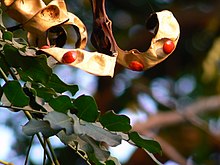Adenanthera pavonina
| Adenanthera pavonina | |
|---|---|
 |
|
|
Adenanthera pavonina manjadi
with the red seeds, India. |
|
| Scientific classification | |
| Kingdom: | Plantae |
| (unranked): | Angiosperms |
| (unranked): | Eudicots |
| (unranked): | Rosids |
| Order: | Fabales |
| Family: | Fabaceae |
| Genus: | Adenanthera |
| Species: | A. pavonina |
| Binomial name | |
|
Adenanthera pavonina L. |
|
| Synonyms | |
|
|
with the red seeds, India.
Adenanthera pavonina is a perennial and non-climbing species of leguminous tree. Its uses include food and drink, traditional medicine, and timber.
Adenanthera pavonina is commonly called Red Lucky Seed. Other common names for the tree include Acacia Coral, Arbre À Église, Bead Tree, Circassian Seed, Corail Végétale, Coral Wood, Coralitos, Curly Bean, Deleite, Delicia, Dilmawi, Graine-réglisse, Jumbi-Bead, L'Église, Peronías, Peonía, Peonía Extranjera, Red Bead Tree, Red Sandalwood, Red Sandalwood Tree, and Réglisse. Barbados pride, Peacock flower fence, Sandalwood tree, Saga, and Manchadi are additional common names. Synonyms for the tree include Adenanthera gersenii Scheff., Adenanthera polita Miq., and Corallaria parvifolia Rumph. In Kerala where Adenanthera pavonina trees are abundant, the seeds are called Manjadi (മഞ്ചാടി).
The tree is common within the tropics of the old world. It has also been introduced in the following countries of the America
This tree is useful for nitrogen fixation, and it is often cultivated for forage, as an ornamental garden plant or urban tree, and as a medicinal plant. For example, the young leaves can be cooked and eaten. The raw seeds are toxic, but may be eaten when cooked.
Adenanthera pavonina seeds have long been a symbol of love in China, and its name in Chinese is xiang si dou (Chinese: 相思豆), or "mutual love bean". The beauty of the seeds has led to them being used as beads for jewellery. Renowned botanist Edred Corner states that in India, the seeds have been used as units of weight for fine measures, of gold for instance, throughout recorded history because the seeds are known to be almost identical weights to each other. Indeed, the Malay name for the tree, saga, has been traced to the Arabic for 'goldsmith'. The small, yellowish flower grows in dense drooping rat-tail flower heads, almost like catkins. The curved hanging pods, with a bulge opposite each seed, split open into two twisted halves to reveal the hard, scarlet seeds. This tree is used for making soap, and a red dye can be obtained from the wood. The wood, which is extremely hard, is also used in boat-building, making furniture and for firewood.
...
Wikipedia
